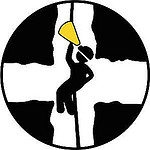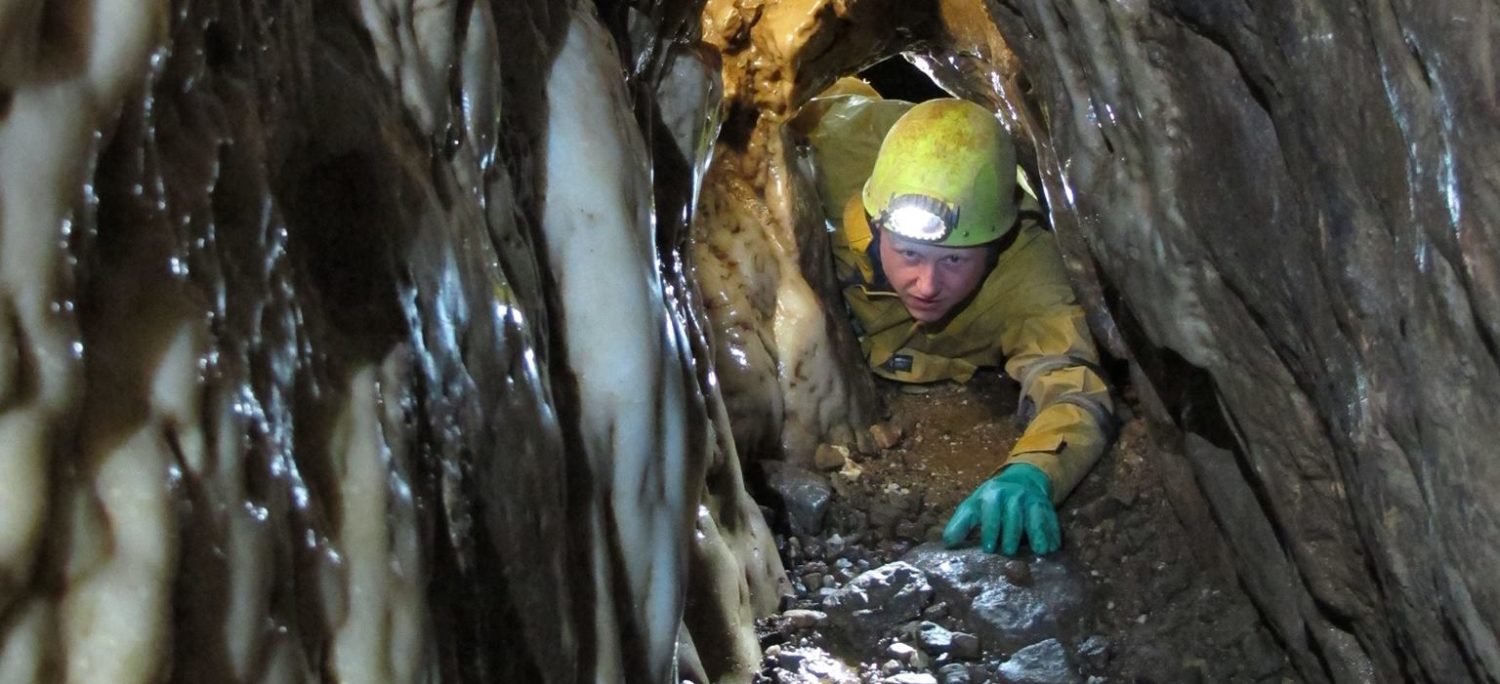By Harvey Connolly
Toward the end of February, we set off on our third club trip of the year, bound for a destination we seldom have an opportunity to visit – Derbyshire, and more specifically, the town of Castleton, where the headquarters of the Technical Speleological Group resides. After collecting and packing the weekend’s equipment into the minibus in terrifyingly efficient time, we set off on our northward journey, falling just short of the initial ETA which would have permitted us time to grace some of the town’s many pubs, but otherwise making good time.
The Technological Speleological Group (or TSG) itself is housed in a building which, one could argue, has experienced a gradual degradation of purpose over the years; from its noble origins as a chapel, the structure eventually found itself converted into a garage and, finally, a base for cavers from which they can marauder outwards across the hills in search of the surrounding subterranean systems. Arriving just after 11pm, we descended from the minibus into the biting chill of the February night, and gradually began the transfer of our supplies into the hut which would serve as home for the following few days. Entering through a main door treacherously located on a roadside between two blind bends, visitors find themselves in a concreted space equipped to store and clean caving gear, before a door atop a brief flight of stairs leads to the hut proper. Here, the large central room has an elevated second tier running three sides of its perimeter, only accessible by ladder, which seems to be used to store various miscellanies, paint cans and stray equipment. With showers on one side of the room, a door on the other leads to a short corridor; from here, it’s possible to access the kitchen, and the flight of stairs which lead to the cosy bunkrooms and a lounge area, kitted out with sofas, surveys, and a myriad of old literature on cave science and past escapades. Here, we considered our options for the weekend to come, relaxing and unwinding after our journey.
The following morning, something unfounded, almost miraculous occurred; our own volition, all of us were awake, semi-functional and gathered in the kitchen over the customary pre-caving fry-up by 9am. While disconcerted once again by our own efficiency, we decided to capitalise on our early start by paying a visit to nearby Peak Cavern, colloquially known as ‘The Devil’s Arse’. After suiting up, we set off through the winding streets of Castleton toward the cave’s entrance, drawing the occasional baffled look from passers-by; whereas most caving huts are relatively isolated, being based in a town meant we benefited from the convenience, but also had to endure the surprise of those locals who perhaps weren’t accustomed to being padded past by groups in helmets and boiler suits.
After several minutes, we arrived at the gaping maw of Peak, set in an alcove between hillsides populated by skeletal trees, with the remnants of Peveril Castle standing sentinel above. Entering through The Vestibule, we followed a concrete path into the showcave, passing wooden equipment prepared to demonstrate the techniques of rope-making, into the gradually sloping, silt-floored Lumbago Walk, where we found ourselves stooping forward to a substantial metal door. After fumbling with the keys, we proceeded into a series of other vast, illuminated spaces and tunnels, before reaching the end of the portion open to the public and propelling ourselves down a rough, metal slide into a deeper section of the cavern.
Following this route, we eventually reached Buxton Water Sump dam, and upon reaching the approach to Surprise View through a series of waist-deep, bracing ducks, we converged into two separate groups. The first remained within Peak Cavern, further exploring the passages and sumps. The rest of us squeezed our ways between the bars of a gate marking the boundary between Peak and neighbouring Speedwell Cavern. While we were technically no longer up The Devil’s Arse, the scatological naming trend continued as we ascended a ladder into the muddy armaggedon which is Colostomy Crawl, an awkward length of tight passage. As we pressed forward, we found ourselves contorting our way through rocky squeezes and slippery stretches, occasionally finding our boots suction from our feet in ankle-deep mud. Never more grateful for the ability to stand, we then descended down a series of steeply inclined ladders and into a meandering streamway, before reaching another ladder immersed in a sheet of cascading white water.
Collecting ourselves for a moment at the top of this ladder, beside the gate leading into the showcave area of Speedwell, we began our journey along perhaps the most intriguing, masochistic stretch of our trip: a wade through the icy snow run-off, which had collected to flood a section of the old abandoned lead mine adjoining the natural parts of the cave. Initially knee deep, the water we maneuvered through gradually encroached up our bodies until we were almost chest deep, while we passed old support struts and the scars left by tools in the walls of the tunnel. At one point, we found ourselves clambering up a rope onto the slick walls, before re-positioning on a series of scaffolding bars which formed a tentative walkway through a particularly deep stretch of water. Eventually emerging from our semi-submerged state, a short shimmy through a breezy squeeze led to an upward climb up a shaft adorned with a scattering of partial ladders, between which we had to awkwardly stretch and clamber, before reaching the conclusion of our inward journey at James Hall, where we spent a brief sojourn warming ourselves in preparation for the return to the surface via Peak. Overall, our route offered a series of new and novel experiences, and physical and psychological challenges, although the most notable facet of the journey was perhaps our trip through the mining area. While natural caves often possess their own unique beauty and points of interest, spending time in a man-made space was both surreal and haunting, a tangible echo of the industrious endeavors of those who had come before us; a space once alive with human activity, now a quiet testament to a bygone time.
Having traipsed back to the TSG upon re-emerging from Peak Cavern, we finally set about accumulating a rabble to investigate the local public houses. Having graced The Bull and The Castle, only to find them both packed to the rafters by rugby fanatics and restaurant goers, respectively, we eventually found ourselves a cosy niche in the corner of The George, a rustic place set back from the main road which wound through the small town. Here, we dabbled in our first game of the weekend, this one a table-top affair with the gloriously irreverent title: ‘Who Shall We Eat?’ Each of us was allocated a character, whom we were to represent in a desert island survival situation. As the game progressed, through a series of card-based actions and the passing of a conch shell to allocate a leader, Lord Of The Flies style, our goals included foraging for sufficient quantities of food to sustain our rag-tag bunch, whilst also accumulating raw materials to construct a craft which would allow us to escape to victory. However, as food supplies became scarce, we would far too readily resort to cannibalism, nominating a member of our team to be unwilling sacrificed and eaten for the greater good, at which point said sacrifice would continue to play as a vengeful spirit, seeking to drive the remaining survivors to madness. An excellent and highly entertaining game, it comes highly recommended – even if I was selected as the first sacrificial victim. I was a sailor. You all needed to escape on a boat. Come on, guys.
As the evening progressed, we proceeded to play a variety of other caving classics in the hut. These included a game of giant Jenga, the stakes increased by precariously balancing a foolish volunteer atop the teetering pile of blocks, and another I’d heard whisper of, but never seen enacted before: sock wrestling, in which, as the name suggests, two participants grapple with each other until one successfully removes an item of clothing from the feet of the other. However, the iteration we ended up playing wasn’t the vanilla version of brute force and footwear theft. Instead, after some deft rope rigging on a support beam in the central room, each competitor rigged themselves up in harnesses and chest tapes, and while suspended from the rope, attempted to steal their opponent’s socks in a grand aerial ballet of flailing limbs, undignified groping and impromptu acrobatics, while the spectators settled themselves amongst the debris on the upper tier as though it were the stand of a budget colosseum.
The following morning, we decided to put the rope to more responsible use, fine-tuning our SRT skills before venturing to one of Derbyshire’s more vertical caves. As somebody with less than optimal skills on a rope, visiting a space named Suicide Hole seemed uncomfortably premonitory, and so myself and a handful of others made the decision to spend our Sunday above, rather than below, ground. After meandering through the tight streets and visiting the local shops, and taking note of the impressive pub-and-jewellery-stores-to-other-building ratio, we zigzagged our way along a steep incline to the crumbling wall and ruined twelfth-century keep of Peveril Castle, where we overlooked the town nestled amidst the rolling hills before us, and the rugged, craggy landscape punctuated by gentle rivulets of water behind us. Having laden ourselves up with all manner of paraphernalia from the local sweet shop, we spent a restful afternoon in the hut playing Exploding Kittens and drinking a substantial quantity of tea. Once again, it was a wonderful weekend with Reading University Caving Club, with new challenges, old friends, and plenty of memories in the making!
 Reading University Caving Club
Reading University Caving Club 